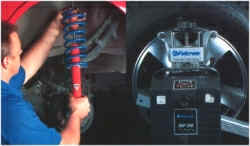Chapter 5: CAR SUSPENSION
Shock absorbers play a vital role in the safety of your car. They improve handling, braking and control. Don’t discover your shock absorbers are worn, by accident.
Shock absorbers control the contact between your car’s wheels and the road surface. They balance and stabilize your car so it is safer and more comfortable to drive.
Shock absorbers use 2 damping forces which act together to prevent wheels lifting and to balance and stabilize the car body to provide a firm grip on the road.
Like many components on a car shock absorbers wear out.
Every 20,000km a shock absorber can perform 15-20 million cycles of movement. As such leading suspension companies like Fulcrum Suspension suggest you have your shock absorbers checked professionally at least every 40,000 km.
They may not need replacing at this stage, but a check this often (usually performed at no charge) will provide peace of mind.
You don’t need to be a mechanic though to see the signs of worn shock absorbers. Any of the following problems may indicate worn shock absorbers requiring professional inspection;
- The vehicle nose-dives under heavy braking, the bonnet dips excessively increasing braking distance. The could be as much as 2.6 m further to stop at 80 km/hr.
- The steering wheel vibrates, sometimes wrongly diagnosed as a wheel alignment or wheel balance problem
- The vehicle shakes, rattles and rolls due to lack of damping forces and the vehicle does not hug the road on bends. Worn shocks mean that over bumps the wheels bounce and tyres loose contact with the road surface.
- The vehicle veers sideways in cross winds or swerves sideways under heavy braking
- The shock absorbers leak oil. Check the ground after parking your car overnight.
- The tyres on the vehicle wear unevenly, due to wheels bouncing uncontrollably. Bald patches develop called scalloping.
Any of these observations will leave no doubt as to the condition of the shock absorbers.
One final test that can easily be undertaken is the age old bounce test.
THE BOUNCE TEST
With your car parked safely, push down firmly on the boot, the vehicle should bounce back and settle in place after one bounce. Repeat this test several times at the boot and then test the front suspension by pushing several times on the bonnet. If the vehicle continues to rock several times; like this it is a good sign the shock absorbers have worn.
Do not discover your shock absorbers are worn by accident. If in any doubt talk to your local suspension expert.
(Written by Joel Neilsen, Managing Director, Safe Drive Training)



